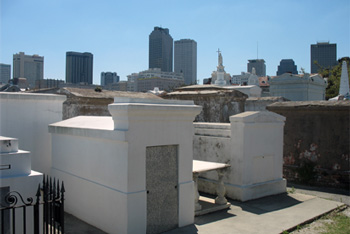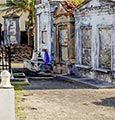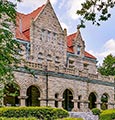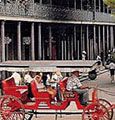Cities of the Dead
With row after row of above-ground tombs, New Orleans cemeteries are often referred to as “Cities of the Dead." Enter the cemetery gates, and you will be greeted by rusty decorative ironwork and blinded by sun-bleached tombs. Crosses and statues jutting from tomb surfaces cast contrasting shadows, adding to the sense of mystery. Votive candles line tombs on holidays, reminding you that the dead have living relatives who still care.
 Why Above-Ground Tombs?
Why Above-Ground Tombs?
New Orleans has always respected its dead, but this isn't the reason that our departed loved ones are interred above ground. Early settlers in the area struggled with different methods to bury the dead. Burial plots are shallow in New Orleans because the water table is very high. Dig a few feet down, and the grave becomes soggy, filling with water. The casket will literally float. You just can't keep a good person down! The early settlers tried placing stones in and on top of coffins to weigh them down and keep them underground. Unfortunately, after a rainstorm, the rising water table would literally pop the airtight coffins out of the ground. To this day, unpredictable flooding still lifts the occasional coffin out of the ground in areas above the water table, generally considered safe from flooding.
Another method was to bore holes in the coffins. This method also proved to be unsuitable. Eventually, New Orleans' graves were kept above ground, following the Spanish custom of using vaults. The walls of some cemeteries here are made of economical vaults stacked on top of one another, while wealthier families could afford the larger, ornate tombs with crypts. Many family tombs look like miniature houses, complete with iron fences. The rows of tombs resemble streets. This is why New Orleans burial plots quickly became known as Cities of the Dead.
Here is a question for you: how can you bury more than one family member in each vault? How can a tomb hold all of those coffins? According to a local ordinance, as long as the previously deceased family member has been dead for at least two years, the remains of that person can be moved to a specially-made burial bag and placed at the side or back of the vault. The coffin is then destroyed, and the vault is now ready for a newly deceased family member. What happens if a family member dies within that two-year period? Generally, local cemeteries are equipped with temporary holding vaults, and the newly deceased family member is moved into his or her final resting place when two years have elapsed.
History: Above-Ground Tombs in New Orleans
The Old and the Not So New
On your way into New Orleans from the airport, you'll catch a glimpse of the newer Metairie cemeteries. The city's older, more dilapidated cemeteries are St. Louis Numbers 1, 2, and 3, located near the French Quarter. The older cemeteries' paths are twisted; crumbled corners of tombs jut out, and dead ends add to an eerie atmosphere. Pirates, politicians (notice how those two go together?), and voodoo queens are buried in these cities. Explorers should take caution though. While the “Cities of the Dead" are alluring, they can be dangerous. Don't go alone, but travel with a group or with one of the tour companies here.
Cemetery Tours
-

-

Livery Tours Garden District and Cemetery Tour
A historian guide will take you on a two-hour walking tour of the opulent Garden District, where the wealthy Americans settled (they weren’t exactly made welcome in the French Quarter). You’ll marvel at mansion after mansion, surrounded by breathtaking gardens. Afterward, you’ll visit Lafayette Cemetery #1, setting for some of your favorite movies based on Anne Rice's books, including the vampire Lestat’s tomb. -

Livery Tours Voodoo and Cemetery Walking Tour
Learn the mystery and history of voodoo in New Orleans as you stroll the French Quarter. Discover the origins of jazz and uncover the brutal realities of America’s largest slave rebellion on this 2-hour tour. -

Cemetery & Voodoo Tour »
To visit our most notable cemetery, featuring the tomb of Marie Laveau, we recommend the Cemetery/Gris Gris tour by Gray Line.
BOOK NOW -

Super City Tour »
For a stop at one of our cemeteries as part of our larger city-wide tour, check out Gray Line's supercity tour!
BOOK NOW
Top 10 Must-See Cemeteries in New Orleans
There are 42 cemeteries in the New Orleans area, all with fascinating tales to tell. Learn about 10 of the city's most famous cemeteries below. Again, for your own safety, go with a group or with a tour.
St. Louis 1
425 Basin Street
- The city’s oldest cemetery, founded in the late 1700s
- Still the site of several burials a year
- Chess champion Paul Morphy, Homer Plessy of the landmark case Plessy vs. Ferguson, an architect who became one of Jean Lafitte’s pirates, the city’s first African-American mayor, voodoo queen Marie Laveau and many others
- White pyramid is the future resting place of actor Nicolas Cage
- Location for scenes from the movies Cincinnati Kid (1965) and Easy Rider (1969)
- Open Monday through Saturday from 9 a.m. to 3:30 p.m., and Sunday from 9 a.m. to 12:30 p.m.
- In 2010, actor Nicolas Cage purchased a lot of land in the cemetery and commissioned a pyramid-shaped tomb to be built as his future final resting place
- The plaintiff from the landmark 1896 Plessy v. Ferguson Supreme Court decision on civil rights
- A womanizing gambling political millionaire who’d challenge anyone to a duel
- An architect who allegedly became one of Jean Lafitte's pirates
- Earliest World Champion of Chess
- Chief of the Golden Star Hunters and President of the Mardi Gras Indian Council
- The Governors Wives who both died of Yellow Fever
- The first mayor of New Orleans also doubled as a wealthy pioneer of the sugar industry
- New Orleans first African-American mayor
St. Louis 2
300 N Claiborne Avenue
- Opened in 1823 after yellow fever and cholera outbreaks
- Known for ornate ironwork and Greek Revival-style tombs
- Earl King and R&B legend Ernie K. Doe share a tomb here
- Open Monday through Saturday from 9 a.m. to 3 p.m., and Sunday from 9 a.m. to 12 p.m.
St. Louis 3
3421 Esplanade Avenue
- Opened in 1854
- Built upon a former leper colony
- Carved stone angels adorn the entrance area
- 10,000 burial sites and 3,000 wall vaults
- Storyville photographer E.J. Bellocq is buried here
- Open Monday through Saturday from 9 a.m. to 3 p.m., and Sunday from 9 a.m. to 12 p.m
Lafayette Cemetery 1
1416-1498 Washington Avenue
- A non-denominational, non-segregated cemetery in the Garden District, founded in 1833
- The oldest of the seven municipal, city-operated cemeteries in New Orleans.
- There are immigrants from over 25 different countries and natives of 26 states interred here
- Home to society tombs for several volunteer fireman organizations, the Independent Order of Odd Fellows, Home For Destitute Orphan Boys, Poydras Orphans Home, and the New Orleans Home for Incurables and others
- Final resting place of Judge Ferguson of the Plessy vs. Ferguson “separate-but-equal” case
- Anne Rice used this cemetery for inspiration for The Mayfair Witches and the Vampire Lestat tombs
- Open Monday through Sunday from 7 a.m. to 3 p.m.
St. Roch Cemeteries 1 & 2
1725 St Roch Avenue
- Parish founded in 1847
- Gothic Revival chapel with side room filled with intimate hand-written thank-you notes, coins, crutches, and other offerings
- Fantastic tile mosaics of saints
- Intricately framed headstone photo memorials
- Open Monday through Saturday from 9 a.m. to 3 p.m., and Sunday from 9 a.m. to 12 p.m.
Metairie Cemetery
5100 Pontchartrain Boulevard
- Named one of the most beautiful cemeteries in the country
- Placed on the National Register of Historic Places in 1991
- Oval shape can be traced back to its days as a race track
- It became a cemetery after the Civil War (charter granted 1872)
- Final resting place of over 9,000 people
- Notables include nine Louisiana governors, seven mayors of New Orleans, 49 kings of Carnival, and three Confederate generals, including P.G.T. Beauregard
- Louis Prima, the world-famous singer, and entertainer is also buried here
- Restauranteurs buried here include Al Copeland (Popeye’s), Ruth Fertel (Ruth’s Chris Steakhouse), and the original owners of Antoine’s, Brennan’s, Arnaud’s, and Galatoire’s
- Open daily from 7:30 a.m. to 5:30 p.m.
Greenwood Cemetery & Mausoleum
5200 Canal Boulevard
- Opened in 1852 by the Fireman’s Charitable and Benevolent Assoc.
- One of the city’s largest cemeteries with around 20,500 lots
- Averages 1,000 interments annually
- The Elks Lodge tomb, erected in 1912, is topped by a gigantic bronze elk statue
- The Confederate Monument, with busts of Robert E. Lee and Stonewall Jackson, contains the remains of 600 soldiers
- Open Monday through Sunday from 8:30 a.m. to 4:30 p.m.
Cypress Grove Cemetery
120 City Park Avenue
- Built in 1840
- The first cemetery in New Orleans to honor volunteer firemen
- The entrance to the cemetery is flanked by pylons in the Egyptian Revival Style
- Many prominent Protestant New Orleanians are buried here
- Final resting place of Maunsel White, a Battle of New Orleans veteran who was the first to use Tabasco peppers to make a hot sauce
- Open Monday through Sunday from 8:30 a.m. to 4:30 p.m.
Holt Cemetery
635 City Park Avenue
- Originally built for the city’s indigent population,
- 99 percent of its population is buried below ground
- Personal marks on the graves and oak trees make visiting a unique experience
- Open Monday through Friday from 8 a.m. to 2:30 p.m., and Saturday from 8 a.m. to 12 p.m.
Charity Hospital & Katrina Memorial Cemetery
5050 Canal Street
- The final resting place for thousands who died in Charity Hospital, particularly during yellow fever epidemics
- Over four days in September of 1847, the corpses of 87 yellow fever victims were buried here
- The land was raised so graves are underground
- Home to the 2007 Katrina Memorial which remembers the unidentified and unclaimed victims of the 2005 storm
- Hours vary



